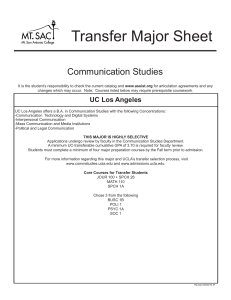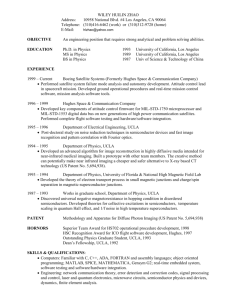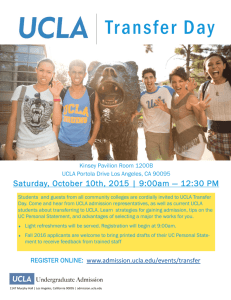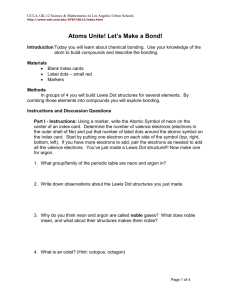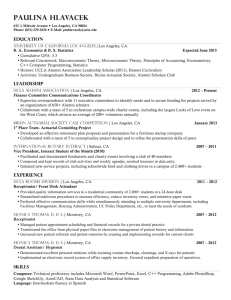Gas Law, Value of R - HighSchoolScienceTFALA
advertisement
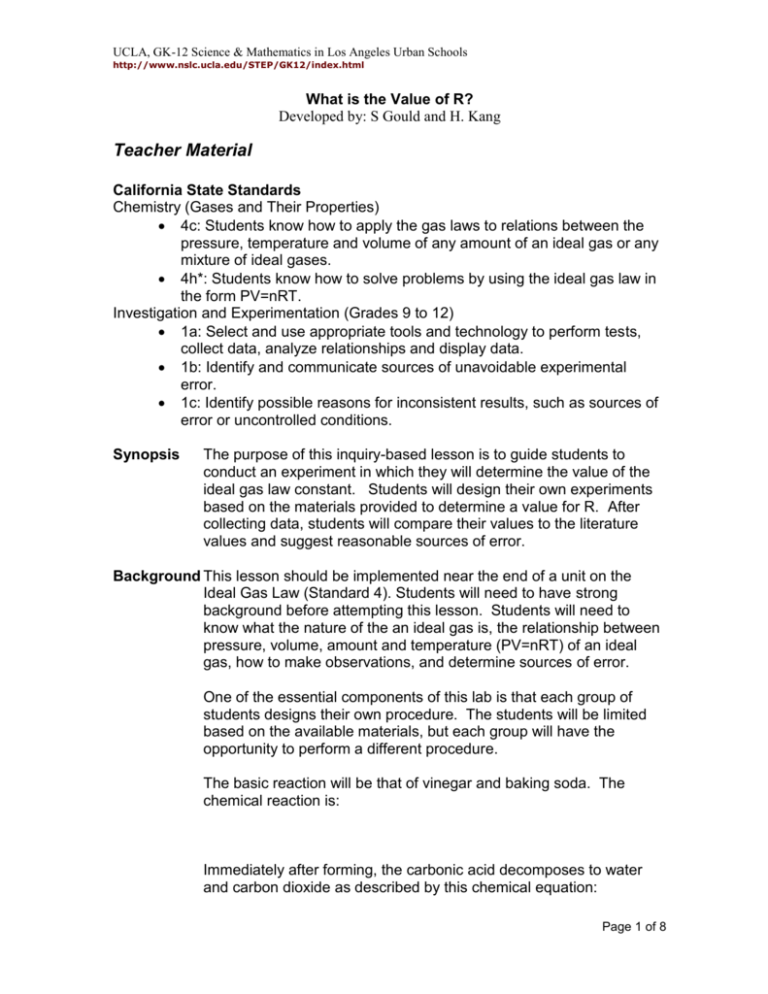
UCLA, GK-12 Science & Mathematics in Los Angeles Urban Schools http://www.nslc.ucla.edu/STEP/GK12/index.html What is the Value of R? Developed by: S Gould and H. Kang Teacher Material California State Standards Chemistry (Gases and Their Properties) 4c: Students know how to apply the gas laws to relations between the pressure, temperature and volume of any amount of an ideal gas or any mixture of ideal gases. 4h*: Students know how to solve problems by using the ideal gas law in the form PV=nRT. Investigation and Experimentation (Grades 9 to 12) 1a: Select and use appropriate tools and technology to perform tests, collect data, analyze relationships and display data. 1b: Identify and communicate sources of unavoidable experimental error. 1c: Identify possible reasons for inconsistent results, such as sources of error or uncontrolled conditions. Synopsis The purpose of this inquiry-based lesson is to guide students to conduct an experiment in which they will determine the value of the ideal gas law constant. Students will design their own experiments based on the materials provided to determine a value for R. After collecting data, students will compare their values to the literature values and suggest reasonable sources of error. Background This lesson should be implemented near the end of a unit on the Ideal Gas Law (Standard 4). Students will need to have strong background before attempting this lesson. Students will need to know what the nature of the an ideal gas is, the relationship between pressure, volume, amount and temperature (PV=nRT) of an ideal gas, how to make observations, and determine sources of error. One of the essential components of this lab is that each group of students designs their own procedure. The students will be limited based on the available materials, but each group will have the opportunity to perform a different procedure. The basic reaction will be that of vinegar and baking soda. The chemical reaction is: Immediately after forming, the carbonic acid decomposes to water and carbon dioxide as described by this chemical equation: Page 1 of 8 UCLA, GK-12 Science & Mathematics in Los Angeles Urban Schools http://www.nslc.ucla.edu/STEP/GK12/index.html Objectives 1. Students will conduct design an experiment to determine R 2. Students will develop math skills by calculating R. 3. Students will evaluate their design and test changes to improve their procedure. 4. Students will learn to identify sources or error. Suggested Timeline Day one. Initial design and trial run of procedure. 50 min. Day two. Data collection and analysis. 50 min. Materials (for each group, cost) Vinegar (of known concentration) Baking Soda Erlenmeyer Flasks, 2 or 3 if possible (50 mL) Beakers, 2 or 3 if possible (50 mL) Small plastic bottle (small water bottles make a good option, ~250m mL) Balloons (2) Plastic Sandwich bags (3) Small paper bag String, rubber bands and twisty ties (several) Calculators Teacher’s Tips This lesson requires students to come up with their own procedure. If this is the first time students have undertaken an experiment like this, additional time and instruction may be necessary for students to get started. Classroom Activities 1. Warm up – Review of PV=nRT and the properties of an ideal gas. 2. Students break up into groups of 4-6 (depending on size of the class and how many groups are manageable) 3. Students will need to read the introduction of their worksheet. It may be best if the introduction and instructions are read aloud by students so that everyone has the opportunity to ask questions 4. Students are told to design an experiment based on the information they have just been presented with. 5. Students are instructed to show their procedure to the teacher BEFORE trying the experiment. Below are some things to look for a. Students are using no more than 0.5 g of baking soda b. Students are using at least 15 mL of Vinegar (they can use more) Page 2 of 8 UCLA, GK-12 Science & Mathematics in Los Angeles Urban Schools http://www.nslc.ucla.edu/STEP/GK12/index.html c. Students are measuring the Temperature, Volume, Pressure, and Weight/Volume of reagents (in the proper units) d. NOTE: If no barometer is available for pressure to be measured, the pressure can be found on-line. Please look at the resources section for more information. 6. Remind students they will need to test their procedure once and make changes. The final procedure needs to be repeated 3 times! 7. Students may pour their waste down the drain (as long as commercially available vinegar and baking soda are used as reagents). 8. Provide time at the end of the class period or the next day have time to calculate the value of R (more information on how to calculate R is provided on the student handout). 9. Have students write their average value of R on the board 10. Lead a discussion on why the values may be different (What are the most likely sources of error). Resources Local pressure values can be found on the National Oceanic and Atmospheric Administration (NOAA)’s website: http://www.noaa.gov/ Page 3 of 8 UCLA, GK-12 Science & Mathematics in Los Angeles Urban Schools http://www.nslc.ucla.edu/STEP/GK12/index.html (STUDENT HANDOUT BEGINS) What is the Value of R?? PART I DATA COLLECTION Introduction Today’s lab will focus on the ideal gas law constant. You have already learned about ideal gases. Now using your knowledge you will design an experiment to determine the value of R. Normally you write the ideal gas law equation as PV=nRT, but the equation can be algebraically re-arranged to: R = PV/nT. R can be calculated by determining values for P (pressure), V (volume), n (number of moles) and T (temperature). When baking soda and vinegar are combine a chemical reaction occurs. The chemical reaction is described by the following equation: Carbonic Acid (H2CO3) spontaneously decomposes according to the following equation: Carbon dioxide (CO2) is an ideal gas. Using the above information and the materials provided design a procedure to determine the value of R. Get your teacher to initial the design BEFORE you try it! Materials Vinegar (of known concentration) Baking Soda Erlenmeyer Flasks, 2 or 3 if possible (50 mL) Beakers, 2 or 3 if possible (50 mL) Small plastic bottle (small water bottles make a good option, ~250m mL) Balloons (2) Plastic Sandwich bags (3) Small paper bag String, rubber bands and twisty ties (several) Calculators Page 4 of 8 UCLA, GK-12 Science & Mathematics in Los Angeles Urban Schools http://www.nslc.ucla.edu/STEP/GK12/index.html Questions & Data Collection 1. Write out each step of your initial experimental procedure. Teacher’s Initials _______ 2. After testing your procedure once, what improvements can be made? 3. Write out each step of your final procedure. Teacher’s Initials _______ Page 5 of 8 UCLA, GK-12 Science & Mathematics in Los Angeles Urban Schools http://www.nslc.ucla.edu/STEP/GK12/index.html 4. What is the limiting reagent? How many moles of the limiting regent are you using? 5. How many moles (n) of gas are produced during your reaction? 6. Test your procedure at least 3 times. Fill out the following chart with your data. Pressure (P) Volume (V) # of Moles (n) Temperature (T) Trial 1 Trial 2 Trial 3 Page 6 of 8 UCLA, GK-12 Science & Mathematics in Los Angeles Urban Schools http://www.nslc.ucla.edu/STEP/GK12/index.html Discussion Questions & Data Collection 1. Calculate R for each trial (Remember R = PV/nT), Circle your answers 2. What is your average value for R? 3. Is your value more or less than the known value (given to you by your teacher) Page 7 of 8 UCLA, GK-12 Science & Mathematics in Los Angeles Urban Schools http://www.nslc.ucla.edu/STEP/GK12/index.html 4. What are some sources of error in your experimental design? 5. What changes would you make to your procedure to reduce the error? (STUDENT HANDOUT ENDS) Page 8 of 8
